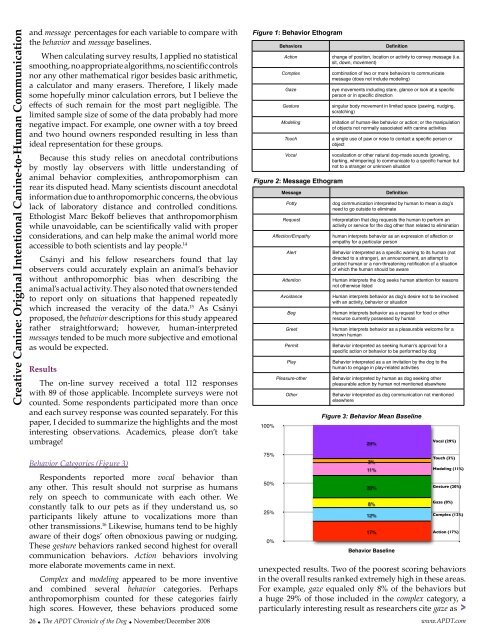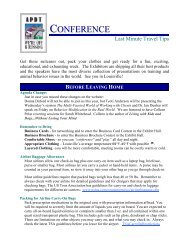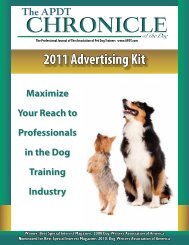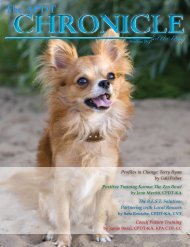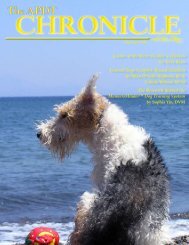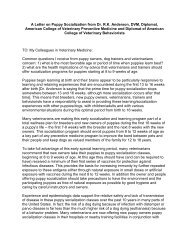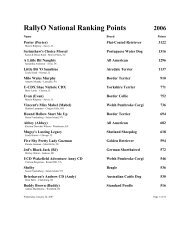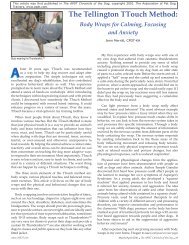of the Dog - Association of Pet Dog Trainers
of the Dog - Association of Pet Dog Trainers
of the Dog - Association of Pet Dog Trainers
Create successful ePaper yourself
Turn your PDF publications into a flip-book with our unique Google optimized e-Paper software.
Creative Canine: Original Intentional Canine-to-Human Communication<br />
and message percentages for each variable to compare with<br />
<strong>the</strong> behavior and message baselines.<br />
When calculating survey results, I applied no statistical<br />
smoothing, no appropriate algorithms, no scientific controls<br />
nor any o<strong>the</strong>r ma<strong>the</strong>matical rigor besides basic arithmetic,<br />
a calculator and many erasers. Therefore, I likely made<br />
some hopefully minor calculation errors, but I believe <strong>the</strong><br />
effects <strong>of</strong> such remain for <strong>the</strong> most part negligible. The<br />
limited sample size <strong>of</strong> some <strong>of</strong> <strong>the</strong> data probably had more<br />
negative impact. For example, one owner with a toy breed<br />
and two hound owners responded resulting in less than<br />
ideal representation for <strong>the</strong>se groups.<br />
Because this study relies on anecdotal contributions<br />
by mostly lay observers with little understanding <strong>of</strong><br />
animal behavior complexities, anthropomorphism can<br />
rear its disputed head. Many scientists discount anecdotal<br />
information due to anthropomorphic concerns, <strong>the</strong> obvious<br />
lack <strong>of</strong> laboratory distance and controlled conditions.<br />
Ethologist Marc Bek<strong>of</strong>f believes that anthropomorphism<br />
while unavoidable, can be scientifically valid with proper<br />
considerations, and can help make <strong>the</strong> animal world more<br />
accessible to both scientists and lay people. 14<br />
Csányi and his fellow researchers found that lay<br />
observers could accurately explain an animal’s behavior<br />
without anthropomorphic bias when describing <strong>the</strong><br />
animal’s actual activity. They also noted that owners tended<br />
to report only on situations that happened repeatedly<br />
which increased <strong>the</strong> veracity <strong>of</strong> <strong>the</strong> data. 15 As Csányi<br />
proposed, <strong>the</strong> behavior descriptions for this study appeared<br />
ra<strong>the</strong>r straightforward; however, human-interpreted<br />
messages tended to be much more subjective and emotional<br />
as would be expected.<br />
Results<br />
The on-line survey received a total 112 responses<br />
with 89 <strong>of</strong> those applicable. Incomplete surveys were not<br />
counted. Some respondents participated more than once<br />
and each survey response was counted separately. For this<br />
paper, I decided to summarize <strong>the</strong> highlights and <strong>the</strong> most<br />
interesting observations. Academics, please don’t take<br />
umbrage!<br />
Behavior Categories (Figure 3)<br />
Respondents reported more vocal behavior than<br />
any o<strong>the</strong>r. This result should not surprise as humans<br />
rely on speech to communicate with each o<strong>the</strong>r. We<br />
constantly talk to our pets as if <strong>the</strong>y understand us, so<br />
participants likely attune to vocalizations more than<br />
o<strong>the</strong>r transmissions. 16 Likewise, humans tend to be highly<br />
aware <strong>of</strong> <strong>the</strong>ir dogs’ <strong>of</strong>ten obnoxious pawing or nudging.<br />
These gesture behaviors ranked second highest for overall<br />
communication behaviors. Action behaviors involving<br />
more elaborate movements came in next.<br />
Complex and modeling appeared to be more inventive<br />
and combined several behavior categories. Perhaps<br />
anthropomorphism counted for <strong>the</strong>se categories fairly<br />
high scores. However, <strong>the</strong>se behaviors produced some<br />
Figure 1: Behavior Ethogram<br />
Behaviors Definition<br />
Action change <strong>of</strong> position, location or activity to convey message (i.e.<br />
sit, down, movement)<br />
Complex combination <strong>of</strong> two or more behaviors to communicate<br />
message (does not include modeling)<br />
Gaze eye movements including stare, glance or look at a specific<br />
person or in specific direction<br />
Gesture singular body movement in limited space (pawing, nudging,<br />
scratching)<br />
Modeling imitation <strong>of</strong> human-like behavior or action; or <strong>the</strong> manipulation<br />
<strong>of</strong> objects not normally associated with canine activities<br />
Touch a single use <strong>of</strong> paw or nose to contact a specific person or<br />
object<br />
Vocal vocalization or o<strong>the</strong>r natural dog-made sounds (growling,<br />
barking, whimpering) to communicate to a specific human but<br />
not to a stranger or unknown situation<br />
Figure 2: Message Ethogram<br />
Message Definition<br />
Potty dog communication interpreted by human to mean a dog!s<br />
need to go outside to eliminate<br />
Request interpretation that dog requests <strong>the</strong> human to perform an<br />
activity or service for <strong>the</strong> dog o<strong>the</strong>r than related to elimination<br />
Affection/Empathy human interprets behavior as an expression <strong>of</strong> affection or<br />
empathy for a particular person<br />
Alert Behavior interpreted as a specific warning to its human (not<br />
directed to a stranger), an announcement, an attempt to<br />
protect human or a non-threatening notification <strong>of</strong> a situation<br />
<strong>of</strong> which <strong>the</strong> human should be aware<br />
Attention Human interprets <strong>the</strong> dog seeks human attention for reasons<br />
not o<strong>the</strong>rwise listed<br />
Avoidance Human interprets behavior as dog!s desire not to be involved<br />
with an activity, behavior or situation<br />
Beg Human interprets behavior as a request for food or o<strong>the</strong>r<br />
resource currently possessed by human<br />
Greet Human interprets behavior as a pleasurable welcome for a<br />
known human<br />
Permit Behavior interpreted as seeking human!s approval for a<br />
specific action or behavior to be performed by dog<br />
Play Behavior interpreted as a an invitation by <strong>the</strong> dog to <strong>the</strong><br />
human to engage in play-related activities<br />
Pleasure-o<strong>the</strong>r Behavior interpreted by human as dog seeking o<strong>the</strong>r<br />
pleasurable action by human not mentioned elsewhere<br />
O<strong>the</strong>r Behavior interpreted as dog communication not mentioned<br />
elsewhere<br />
unexpected results. Two <strong>of</strong> <strong>the</strong> poorest scoring behaviors<br />
in <strong>the</strong> overall results ranked extremely high in <strong>the</strong>se areas.<br />
For example, gaze equaled only 8% <strong>of</strong> <strong>the</strong> behaviors but<br />
a huge 29% <strong>of</strong> those included in <strong>the</strong> complex category, a<br />
particularly interesting result as researchers cite gaze as ><br />
26 w The APDT Chronicle <strong>of</strong> <strong>the</strong> <strong>Dog</strong> w November/December 2008 www.APDT.com<br />
Value Title<br />
100%<br />
75%<br />
50%<br />
25%<br />
0%<br />
Figure 3: Behavior Mean Baseline<br />
29%<br />
3%<br />
11%<br />
20%<br />
8%<br />
12%<br />
17%<br />
Behavior Baseline<br />
Vocal (29%)<br />
Touch (3%)<br />
Modeling (11%)<br />
Gesture (20%)<br />
Gaze (8%)<br />
Complex (12%)<br />
Action (17%)


